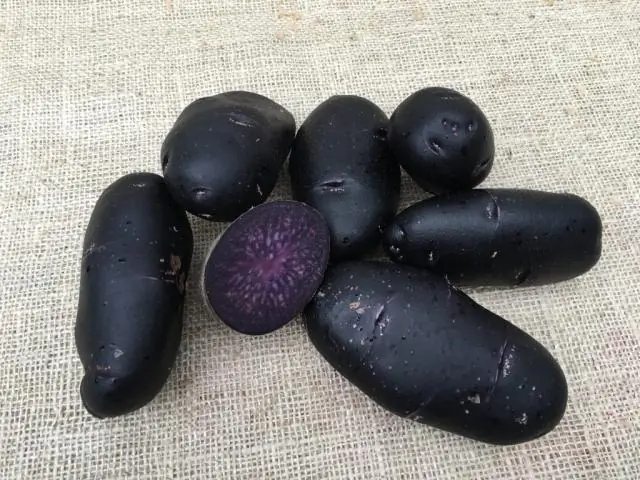
Table of contents:
- Cabbage Aggressor F1: features of the variety, planting and care
- Brief history of the variety
- Characteristics of the Aggressor cabbage variety
- Landing features and care nuances
- Diseases and pests characteristic of the Aggressor cabbage variety
- Harvesting and storage
- Reviews of gardeners about the Aggressor cabbage variety
- Author Bailey Albertson [email protected].
- Public 2024-01-17 22:26.
- Last modified 2025-06-01 07:32.
Cabbage Aggressor F1: features of the variety, planting and care

Cabbage is one of the few fresh vegetables that can be stored all winter without loss of quality. It is a source of not only vitamins, but also fiber, so necessary for the body during cold weather. Thanks to white cabbage with a skillful combination of spices, we have the opportunity to enjoy delicious salads all winter, enriching the body with useful substances presented in summer. The safety of the crop in the cold season directly depends on the correctly selected variety of cabbage. The F1 Aggressor is such a variety. Not only can it withstand drought or heavy rainfall, but it also retains its taste six months after harvest.
Content
-
1 Brief history of the variety
1.1 Video: Cabbage Aggressor F1
-
2 Characteristics of the Aggressor cabbage variety
- 2.1 Productivity, average weight and maturation of cabbage Aggressor
- 2.2 The appearance of the heads of cabbage, their taste and other features
-
2.3 Advantages and disadvantages of the variety
2.3.1 Table: advantages and disadvantages of the Aggressor variety
-
3 Features of landing and nuances of care
-
3.1 Site selection, soil preparation and planting material
3.1.1 Video: growing late cabbage Aggressor F1
-
3.2 Landing time and pattern
3.2.1 Video: planting cabbage seedlings
-
3.3 Watering, loosening, dressing
3.3.1 Table: top dressing scheme
- 3.4 Other important features
-
-
4 Diseases and pests characteristic of the Aggressor cabbage variety
-
4.1 Table: diseases, pests and methods of their control
4.1.1 Photo Gallery: Cabbage Diseases and Pests Aggressor
- 4.2 Video: keela cabbage and the fight against it
-
-
5 Harvesting and storage
5.1 Video: three options for storing cabbage
- 6 Reviews of gardeners about the Aggressor cabbage variety
Brief history of the variety

Cabbage variety Aggressor F1 fully lives up to its name
Bred in 2000, the Aggressor cabbage variety fully lives up to its name. It was included in the state register of the Russian Federation in 2003. The Dutch company "Syngenta Seeds" gave the world this excellent variety, which many gardeners immediately fell in love with. The heads of Aggressor cabbage are juicy, with a delicious taste, and the plant itself has a high resistance to drought and heavy rain, while the quality and quantity of the crop declared by the seed manufacturer does not suffer.
Video: cabbage Aggressor F1
Characteristics of the Aggressor cabbage variety
Every gardener strives to harvest a high-quality crop, but unexpected and unfavorable weather for plants often becomes on the way to the goal. Cabbage Aggressor conquered the hearts of gardeners with its appearance in the beds, having passed numerous tests with rain, scorching sun and strong winds.

The aggressor is resistant to both drought and heavy rain
Productivity, average weight and maturation of cabbage Aggressor
Today, the most popular hybrid of white cabbage Aggressor belongs to the mid-late varieties. From the moment of sowing the seeds, the growing season is up to 130 days.

The weight of a head of cabbage Aggressor can reach 5 kg
The yield of the variety is another of its distinctive features. The head weighs up to 5 kilograms, and the average weight is 3 kilograms. The aggressor has a high growth rate - up to 650 tons per hectare. It is recommended to sow up to 40 thousand plants per hectare. In the Moscow region, the maximum recorded yield of the Aggressor variety stopped at around 800 centners per hectare.

The growing season of cabbage is up to 130 days
The appearance of heads of cabbage, their taste and other features
The harmonious appearance of cabbage is its big plus. The heads of cabbage of the Aggressor variety are flat-rounded, of an average generally accepted size, with barely noticeable yellow veins in the section. Covering leaves of medium-intensity anthocyanin color, slightly wavy edges. The length of both the inner and outer stump is up to 18 cm.

The head of cabbage Aggressor has a harmonious appearance
Cabbage leaf Aggressor is crispy and juicy, high taste. The variety has a pronounced powerful root system. It is an excellent product for fresh consumption, as well as after fermentation or heat treatment.

Cabbage Aggressor can be consumed fresh, as well as after fermentation and heat treatment.
Advantages and disadvantages of the variety
Each plant has its own weak points. Cabbage, for example, does not tolerate drought well, as a result it stops developing, lags behind in growth, and at the end of the growing season is far from ideal commercial qualities. In addition, the Achilles' heel of any cabbage is excessive rain, leading to its cracking, after which the cabbage is not subject to long-term winter storage.

A head of cabbage cracks as a result of excess rainfall
Table: advantages and disadvantages of the Aggressor variety
| Benefits | disadvantages |
| High resistance to drought, rainfall and wind. | |
| High yield rates. | |
| The variety is suitable for growing on different types of soil. | |
| Undemanding to care and watering. | |
| High seed germination - 97%. | Susceptible to the appearance of aphids. |
| Resistant to a lack of nitrogen fertilization. | It is not resistant to some types of fungal diseases, in particular - keela. |
| The head of cabbage retains its integrity with a long stay in the ground. | By the end of the storage period, the leaves become more rigid. |
| The palatability remains for six months after harvest. | |
| Resistant to fusarium and punctate necrosis. | |
| Rarely damaged by thrips and other pests. | |
| It is possible to grow by sowing seeds in the ground. | |
| It tolerates transportation well. |
Landing features and care nuances
Before you start preparing the soil and planting cabbage, you need to know two important nuances:
- Cabbage of any varieties and species cannot be grown on acidic soil, otherwise it will certainly be affected by the keel - a disease inherent in the cruciferous family (rape, all types of cabbage, radish, horseradish). The soil must be deacidified with wood ash.
- Cabbage can be returned to the same place only after 4 years. Otherwise, cabbage will become more vulnerable to diseases and pests inherent in it.

It is recommended to grow cabbage through seedlings
Site selection, soil preparation and planting material
Preparing the soil in the fall is the key to a good harvest and one of the main rules for every gardener. In order for the plants to be less exposed to the invasion of pests and various diseases, it is important to observe crop rotation on the site. The place chosen for planting cabbage is considered successful if the following crops grew on it in the previous season:
- representatives of pumpkin (melon, zucchini, cucumber, pumpkin);
- legumes (beans, beans, peas);
- early potatoes;
- green manure herbs;
- onion;
- garlic.
You cannot plant cabbage in a place where table beets or other types of cabbage have grown before, tomatoes, eggplants and peppers are acceptable precursors of cabbage

Leaves and root system left to winter is a good fertilizer, but the garden becomes unsuitable for replanting cabbage
Soil preparation in the spring begins with digging, while it is advisable not to remove the remnants of the best predecessors that overwintered on the site, since they will serve as a good fertilizer for future plants. Cabbage Aggressor showed good results on "risky" soil, but failed to cope with acidic soil. An indicator of acidic soil is the presence of a large amount of wireworm in the soil and woodlice (grass) on it. To reduce the acidity of the soil, wood ash is evenly scattered over it before digging. No more special preparations for planting cabbage The aggressor does not need to be carried out on the soil - this is an unpretentious plant.

Woodlice weed signals increased soil acidity
The preparation of planting material also does not have to pay special attention, but you still need to decide which method is better for you to plant the Aggressor cabbage: seedling or non-seedling (sowing seeds).

Most gardeners prefer the seedling method of growing cabbage.
Most gardeners prefer seedlings, and this is justified for many reasons. First, weak seedlings are discarded during the growth of seedlings; secondly, for barely hatched seeds, short-term frosts, strong winds, drying up the soil, and heavy rainfalls, leading to damage to defenseless tender shoots, can become a threat. On the other hand, the seedling method is a necessity for early varieties of cabbage, and the middle ones, like the Aggressor, are rationally planted in April for seedlings in a greenhouse.

Bottles serve as mini-greenhouses, protecting weak young plants from possible night frost
For sowing seeds for seedlings in early April or late March, take nutritious soil, prepared in the fall or bought in special stores, put it in a box, make shallow grooves of about 0.5-1 cm (for example, with a spoon handle), and spread it evenly in them seeds, or spread them over the surface without grooves, and then sprinkle them with earth and send them to a windowsill or other warm, well-lit place.

Cabbage seeds are planted to a depth of 0.5-1 cm
Video: growing late cabbage Aggressor F1
You can disinfect it in a weak solution of potassium permanganate or let the seeds hatch by keeping them for 2-3 days in a damp natural cloth. But the Aggressor does not need either one or the other, as practice has shown. Seeds sprout wonderfully without presoaking.

Cabbage seedlings with one real leaf can be planted in a permanent place in the ground
It is important to ensure that the surface of the earth remains always moist, while preventing overflow. Irrigating the soil with a spray bottle is a good solution. When the first true leaf appears on the bush, the seedlings dive into separate containers of a larger shape and leave so until planting, regularly watering as needed. Seedlings should be hardened by bringing the grown seedlings outside, and in the evening they should be brought back into the heat.

Watering from a spray bottle will evenly distribute moisture over the soil and will not damage delicate seedlings
The seedless method is sowing seeds directly into the soil, which also does not require special preparation of seed material, since the Aggressor cabbage is distinguished by good germination and resistance to many diseases and pests.

Cabbage seeds are large and easy to sow
Landing time and pattern
Medium late varieties of cabbage, to which the Aggressor belongs, cannot be planted early, because this variety is harvested with the onset of the first frosts. Only under such conditions will cabbage survive well until mid-spring. In addition, the growing season of the Aggressor is 120-130 days, that is, the harvest should be in September - October.

Cabbage Aggressor can be grown in a seedless way.
Video: planting cabbage seedlings
The optimal time for planting seedlings is mid-May, and with seeds - the end of April. Seedling planting scheme: 40 (between plants) by 60 (between rows) centimeters.

To get a good harvest, the cabbage planting scheme should be followed
The hardened seedlings are planted as follows: they make a hole, spill it abundantly with water, then take a container with a grown seedling, put a palm on its surface, distributing the plant between the index and middle fingers, turn it over - so the young plant remains together with a lump of earth in the palm, and its root system is not damaged.

A cabbage seedling with intact roots is planted in a hole
Then a lump of earth is placed in the hole, but not very deep - slightly above the growth point, sprinkled with earth. If there is a threat of night frosts, the planted young cabbage must be covered with a film - to make it a kind of greenhouse.

The film will protect young plants from wind and bad weather
With the seedless method, furrows are drawn on the ground with a distance of at least 50 cm and a depth of 1 cm, but no more, otherwise the seeds may not break through the thick layer of earth. With a watering can with a sharp nose, furrows are shed and seeds are placed in the soil. If, nevertheless, the sowing turned out to be too thick, then after the emergence of seedlings they need to be thinned out, leaving a distance of at least 35 centimeters between them. Dense planting can cause poor plant development and complete loss of yield. The aggressor needs space - this is a wide and sprawling culture! Cabbage of any kind has large and easy-to-sow seeds, so they can be laid out pointwise into the soil without any problems.

The size of cabbage seeds allows you to lay them out pointwise
Watering, loosening, top dressing
As mentioned above, the Aggressor cabbage variety tolerates drought well, but the dry summer has never had a beneficial effect on the harvest, so cabbage should be watered as needed, but not with too cold water.

Water the cabbage seedlings as needed
Loosening is an important component of growing Aggressor cabbage. When the soil is saturated with oxygen, the plant develops better, and after heavy downpours, loosening is a necessity, since the crust formed on the surface completely blocks the access of oxygen to the plant, and it begins to gradually wither, although the Aggressor is a rather drought-resistant variety of cabbage. The earth is loosened along the entire row with a hoe or other special devices, at the same time removing weeds.

Regular loosening of cabbage promotes better growth
Top dressing is important for any plant, but not vital for the Aggressor. The best fertilizer for cabbage is herbal infusion - grass fermented in water for several days in a ratio of 3: 1. Any weeds are poured into a large container by 2/3 and water is added to the top.
Table: top dressing scheme
| First feeding | Second feeding | Third feeding |
| On the 20th day after planting seedlings, 0.5 liters of mullein are poured under each bush. 500 grams of mullein is bred in a bucket of water, left to brew for several hours in a warm place. | 2 weeks after the first feeding, the plants are watered with the same composition. | Carried out during the formation of the head of cabbage. Now the growth of cabbage will be helped by a mineral complex, for example, 2 tablespoons of Ammofoski are diluted in a bucket of water. 8 liters of solution is enough for one square meter. |
When growing cabbage, the Aggressor should not get carried away with nitrogen fertilizers, which will lead to active growth of lateral leaves, and not the formation of a head of cabbage.

When growing cabbage, do not get carried away with nitrogen fertilizers.
Other important features
The quality and quantity of the crop depends on the correct care of the plant and on the observance of crop rotation in the garden. But there is another important feature that can protect cabbage from pests and prevent diseases - this is mixed planting.

A good option for mixed planting for cabbage: onions, cabbage, parsley
For example, by planting marigolds between the cabbage, you will protect the cabbage from many pests, including cabbage butterflies (the main pest of cabbage), and also make the garden flawlessly beautiful.

Marigolds and calendula protect cabbage from many pests
The secret of mixed plantings is that some exude an odor that repels pests of other plants. Dill, garlic, onions are herbs that many pests cannot tolerate.
One of the examples of a successful mixed planting, when cabbage is planted between rows of previously planted and already grown onion sets. Using this technique, you will not only protect the cabbage from various ailments, but also save space in the garden. Do not worry that such a dense planting will negatively affect the harvest of both crops. Spreading leaves will appear on the cabbage later than the scheduled onion harvest.

Cabbage in onions: plants protect each other, but do not darken
Diseases and pests characteristic of the Aggressor cabbage variety
The only disease that Aggressor cabbage is susceptible to is keela, and based on feedback from gardeners, cabbage in very rare cases can be attacked by cabbage aphids and thrips.
Table: diseases, pests and methods of controlling them
| Disease / pest | Description | Symptoms | Control methods |
| Keela | A fungal disease inherent only in the cruciferous family. | The leaves change their usual color, and then gradually wither. Round-shaped growths are formed at the root, leading to cracking of the leg and head of cabbage. | Affected plants cannot be treated - they are removed from the garden and the soil is disinfected. To secure the future harvest, the clay is diluted in water and the roots of the seedlings are dipped in them before planting, or the seeds are treated with special preparations (for example, Granosan). |
| Cabbage aphid | Many insects of light green color up to 3 mm in size. | The color of the leaves changes to pale pink, and later deformation of the leaf itself is observed, up to complete drying out. | The best and safest way to fight aphids is a soapy solution with wood ash, which is used to wash the plants. A glass with a slide of ash is dissolved in several liters of water, put on fire and boiled for 30 minutes, removed from the heat, cooled and diluted with 50 grams of grated laundry soap. |
| Thrips | Through cracks in the soil, thrips 0.5-2 mm in size rise to its surface, lay eggs on the underside of the leaf. Thrips affect the entire plant, right down to the fruit. | Angular light yellow spots appear on the leaves, eventually changing color to yellow stripes with a silvery tint, and as a result, the whole plant dries up. | Broverin at a concentration of 1%. The drug is diluted according to the instructions in water and the plants are treated twice with a difference of 2 weeks. |
Photo gallery: cabbage diseases and pests Aggressor
-

Keela on cabbage roots - Plants affected by a keel cannot be treated
-

Aphids on a cabbage leaf - Aphids can significantly harm the crop
-

Thrips - Thrips affect the whole plant, right down to the fruit
Video: keela cabbage and the fight against it
Harvesting and storage
Medium late varieties of cabbage are harvested with the onset of the first night frosts. The aggressor tolerates short-term temperatures up to -5 degrees well. By this time, the heads of cabbage have reached full maturity, as indicated by a white, glossy dot on the top of the fork.

The indicator of maturity is a white, glossy dot on the top of the fork.
Colds contribute to better storage of cabbage in a cellar or other special place throughout the winter and most of spring, however, how long and in what condition the harvest will be saved depends largely on the storage conditions.

The first frosts are the best time to harvest medium-late and late varieties
Harvesting Cabbage Aggressor can be done in two ways. The first consists in cutting off the heads of cabbage from the outer stump.

Heads of cabbage can be cut from the outer stump
The second - the plant is dug up together with the root, which is cleared of the earth.

Cabbage can be dug up by the root, peeled and stored as such
Both methods are good, but a root-dug plant is believed to last longer.
The aggressor is a variety of cabbage that lies perfectly until spring without any special conditions. If the fork is dug out with a stump, it is cleaned of lateral leaves, hung on a hook and transferred to a cold, dark place for storage.
Video: three options for storing cabbage
The heads cut off from the stump are also taken away to the future storage place, laid out on shelves, stump down. Particularly scrupulous gardeners wrap the forks in cling film or paper in order to prevent air from reaching them.

The heads are covered with cling film, tightly tightened, hung on a hook and sent for storage
How justified this method is - everyone can decide for himself, however, regular review of the crop during storage for the presence of rotten leaves is a prerequisite in any case. One rotten head of cabbage will destroy the rest of the crop in storage. Darkened and rotten leaves are cut off and put on compost. Under such conditions, the cabbage harvest will delight you with healthy, tasty and full of vitamins for a long time.
Reviews of gardeners about the Aggressor cabbage variety
Aggressor is a variety of cabbage that fully justifies its name. The variety is resistant to bad weather and many diseases. It possesses excellent taste and has high keeping rates without loss of presentation and taste.
Recommended:
Garden Lilies - Planting And Care, Photo And Video (oriental, White, Tubular)

Features of the species and varieties of garden lilies. Tips for planting lily bulbs. advice on growing and care
Enotera Perennial: Planting And Care (pink, Shrub, Etc.) + Photo And Video

Practical advice and advice on planting, growing evening primrose and caring for it. Correct planting, fertilization of the soil
All About Garden Strawberries (strawberries) Varieties Asia - Description, Planting, Care And Other Nuances + Photo

Description of the variety of garden strawberry Asia. Differences between strawberries and strawberries. Planting, care, reproduction. Protection against diseases and parasites. Reviews. Video. Photo
Scottish Straight Cat Scottish Straight: A Description Of The Breed With A Photo, The Nature And Characteristics Of Care, The Choice Of A Kitten And Reviews Of The Owners

Features of the Scottish Straight breed: appearance, character, difference from British shorthair cats. How to choose a pet, take care of him. Owner reviews
Caracal Desert Lynx: Description And Photo Of The Breed, Maintenance And Care At Home, Where To Buy A Steppe Cat

Caracal in the wild. Features of appearance and behavior. Keeping the steppe lynx at home. Diseases of the caracal. Purchase nuances. Reviews
